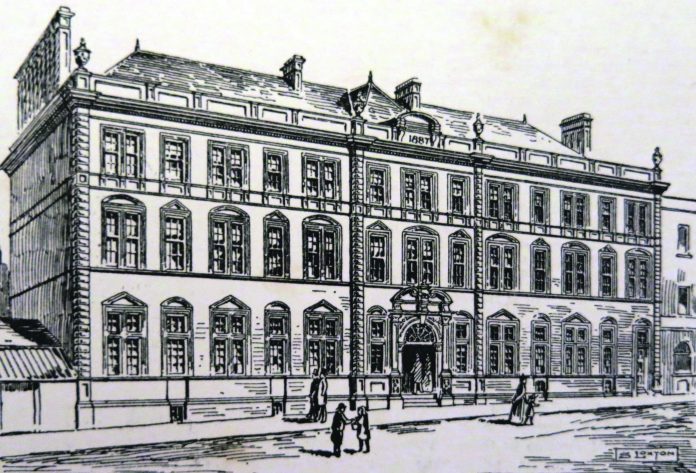It’s a myth that there was little or no access to free medical care before the establishment of the NHS in 1948 – but progress was slow, unequal and sometimes grisly.
Until the mid-1800s, more people in Bristol generally died than survived infancy. Accidents and violence killed some, but far more died of diseases resulting from cramped living conditions, poor hygiene, inadequate sanitation and fluctuating food prices. The population could only be sustained by incomers from surrounding counties and further afield.
Reporting on the stories that matter to you. Only with your support.
Waves of disease regularly carried away huge numbers, from plagues and the mysterious Tudor-era ‘sweating sickness’, to cholera in the 19th century, not to mention endemic diseases like smallpox. Before modern medical science, everyone thought human contact, overcrowding and ‘bad air’ caused disease to spread, which is partly why from the late 1700s wealthier citizens started escaping to the salubrious suburb of Clifton.
Bristol’s population rocketed from around 70,000 to around 330,000 over the 19th century, partly due to medical advances but mostly thanks to improved sewers, clean drinking water, public health initiatives and reliable supplies of affordable food.
We now take such things for granted, as well as free-to-access healthcare, even if the system is now overstretched and underfunded. Our city’s often grisly, pre-NHS medical history is worth taking a look back at, whether or not it makes you feel better about the wait to see your dentist.
The 14th-century Black Death pandemic killed a large proportion, perhaps as high as half, of England’s population. Scraps of testimony from Bristol mention families self-isolating in their homes and grass growing in empty streets, with the death rate in the densely populated city almost certainly far worse than the national average.
Plague was a regular visitor until the mid-1600s. Some outbreaks carried off as many as 2,500 people, around a quarter of Bristol’s Tudor-era population. By then, there were preventive measures in place, including quarantine areas for travellers and goods from London during plague outbreaks.
The Great Plague of 1665-6 was catastrophic for London, but Bristol got off lightly. It already had at least one ‘pest house’ where isolating plague patients would be fed and looked after for free – an incentive for families to place them there. The rather discouragingly named ‘Forlorn Hope’ was in St Nicholas Road, St Paul’s.
Before the 20th century, patients who could afford it were generally treated at home, while hospitals were usually for the poor. The Bristol (later Royal) Infirmary was one the earliest ‘voluntary hospitals’ in the country, founded in the 1730s to treat people, usually free of charge. Funded by local benefactors, medical staff generally worked for free to gain experience or because they felt it was a duty.
The Bristol General Hospital, originally just in a house in Guinea Street, opened on similar lines in the 1830s, as did the Children’s Hospital – originally the Bristol Hospital for Sick Children and for the Outdoor Treatment of Women – which opened in 1866 and is the second-oldest paediatric hospital in England.
Southmead was originally a workhouse with an infirmary, while Frenchay, now closed, was a sanatorium for tuberculosis patients opened by the council in 1921. During the First World War, both were used for war efforts before returning to civilian hands. Frenchay remained one of the region’s major hospitals until 2014.
Ham Green hospital near Pill was a former country house bought by Bristol City Council in the 1890s to use as an isolation hospital for infectious diseases. (Before this, patients had been kept on a ship moored at the mouth of the Avon.) It closed some years ago, but lives on in the folklore of many families.
Because visitors were forbidden, Ham Green allocated patients a number and each day the local press carried a report on the progress of each. That way, families with no access to a telephone could find out how their loved ones were. Treatment was free because it was in the public interest to contain infectious disease.
By the early 20th century, medical science was starting to make a difference. Hospital treatment was usually free, but primary care cost money. By 1939, many families were covered by some sort of insurance, or a friendly society where people would club together to support each other, or were covered under the 1911 National Insurance Act.
The issue of payment was confusing, and many schemes only covered the breadwinner, not the rest of the family. Working-class mothers would often go without paying for treatment in order to see their families fed and clothed.
The costs of seeing a doctor prompted dispensaries to open. Supported by donations, charities, religious organisations or local businesses, there were several in Bristol by the early 20th century, providing a GP service and medicine for the very poorest at low or no cost.
Sometimes there was a catch. The Bristol Medical Mission in Redcross Street, Old Market, required its patients to sit through a 20-minute religious service, with hymns accompanied by a harmonium player, before they could see a doctor.
One of the myths around the establishment of the NHS in 1948 is that previously the working classes had little or no access to medical care. This was not true; by then, all but the poorest could see a doctor easily enough. What the NHS did was make a haphazard and confusing system of private, voluntary, charitable and insured medicine simple, accessible and free for all.
There had been talk of setting up a health service that would provide free medical care for all since well before the Second World War, and in 1942, under Churchill’s wartime coalition government, there emerged a cross-party consensus that something should be done.
It fell to Aneurin Bevan, health minister in the postwar Labour government, to set up the NHS, but this involved a massive amount of work to untangle and incorporate the existing doctors, hospitals, charitable and local authority services. The British Medical Association resisted fiercely. Some doctors simply resented the end of their independence – “the enslavement of a noble profession”, said one.
Doctors in Bristol were among the most resistant. At a meeting attended by 380 doctors from Bristol, Bath and Somerset at the Royal Fort in Clifton in February 1948, 366 voted against the terms of the National Health Service Act. But it came into being in July the same year. Bevan made a few concessions, notably through paying doctors on the number of patients they had rather than salaries, and by allowing private practice to continue. He was quoted as saying, “I had to stuff their mouths with gold”.
Bristol’s long history and great wealth produced a lot of charitable giving. In life and in their wills, rich people left large amounts of money to the community. By Victorian times, the city had a bewildering array of charities and old people’s homes. The voluntary hospitals and dispensaries supported both by ancient charities and fundraising drives were a part of this.
Big local industrial dynasties gave very large sums to local good causes, including the Quaker Fry family who made chocolate, the Wills family who produced tobacco products and mining magnate Handel Cossham who set up an entire hospital. This local philanthropy started to fade with the welfare state, but mostly because globalisation cut the ties between companies and their hometowns.
Despite the massive strain that the NHS is under today, socialised medicine and the immense and continuing advances in medical science have made conditions that were killers only a century ago treatable. But a long-lasting trend for philanthropy among Bristol’s wealthy meant that even in the days before the NHS, this city was probably a better place to be poor and sick than many others.
The Cable is Bristol’s independent, investigative newsroom. Owned and led by 2,600 members, we produce award-winning journalism that digs deep into what’s happening in Bristol. Investigative journalism strengthens democracy – it’s a necessity, not a luxury.
As a democratic members co-op, democracy is built into everything we do. We’re 100% owned by thousands of Bristol members.
If we can triple our membership, this funding from the people of Bristol would make the Cable completely sustainable.
Read more on: health, nhs, people’s history
Home » People’s History »
Join us
Mark if this comment is from the author of the article
By posting a comment you agree to our Comment Policy.
document.getElementById( “ak_js_1” ).setAttribute( “value”, ( new Date() ).getTime() );
This site uses Akismet to reduce spam. Learn how your comment data is processed.
Bristol History Podcast
Arriving at the end of the First World War, the 1918 ‘Spanish’ Flu was one of the deadliest pandemics in human history, killing between 40…
Edition 21
With far-right ideas on the rise again, Colin Thomas draws on first-hand accounts and archive material to tell a story from a generation ago.
Bristol History Podcast
how much do we know about what life was like for the ordinary men and women living under Henry VIII’s rule?
Bristol History Podcast
This week I met with Joe McSorley of the Avon Wildlife Trust to discuss the natural history of the West Country – from the earliest…
Bristol History Podcast
This week I met with Dr. John Reeks to discuss Bristol University and its historians. The university was founded in 1909 and dominates much of…
Bristol History Podcast
Bristol was born as a trading hub. We look at the history of the city’s overseas trade, from its foundation to present day.
Subscribe to the Cable newsletter to get our weekly round-up direct to your inbox every Saturday
The Bristol Cable produces quality local journalism, powered by members. But we need your support to keep going.
Join now
The Bristol Cable is a pioneering grassroots community-led media cooperative based in the City of Bristol
Get our latest stories & essential Bristol news
sent to your inbox every Saturday morning







